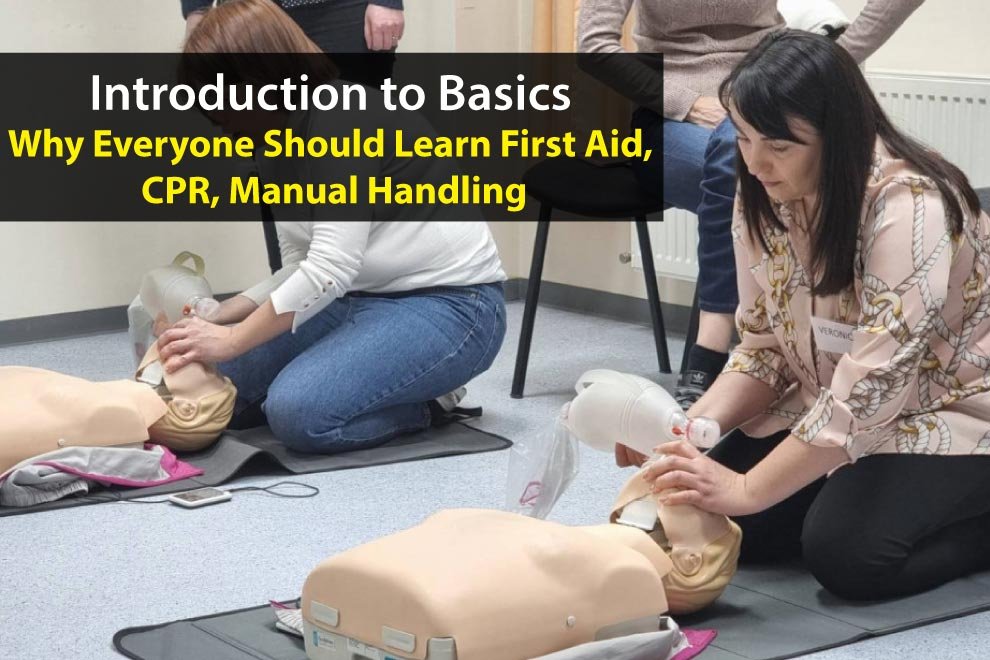In a world where accidents and emergencies can occur at any time, equipping oneself with the knowledge and skills to respond effectively can be life-saving. First aid, CPR (Cardiopulmonary Resuscitation), and manual handling are fundamental skills that everyone should learn.
The Importance of First Aid
First aid is the immediate assistance provided to an injured or ill person before professional medical help arrives. It can range from treating minor cuts and bruises to responding to more serious conditions such as heart attacks or strokes.
The primary reason for learning first aid is its potential to save lives. In critical situations, such as cardiac arrest or severe bleeding, immediate intervention can mean the difference between life and death. Knowing how to perform basic first aid can stabilize a person’s condition until professional medical services take over.
First aid knowledge either from in person training or throughOnline First Aid Course Adelaideenables individuals to take immediate action to prevent a situation from worsening. Being trained in first aid fosters a sense of safety and confidence. Individuals are more likely to take action in emergencies if they are equipped with the necessary skills and knowledge. This preparedness can create a safer environment at home, work, and in the community.
Basic principles of first aid application may include:
Assessing the Situation
Before administering first aid, it is essential to assess the situation to ensure the safety of both the responder and the victim. This involves checking for potential hazards and ensuring that the environment is safe.
Calling for Help
In any emergency, it is vital to call for professional medical assistance as soon as possible. This can involve dialing emergency services or asking someone nearby to make the call.
Providing Immediate Care
Immediate care involves administering the appropriate first aid measures based on the victim’s condition. This could include performing CPR, controlling bleeding, or treating for shock.
Reassuring the Victim
Offering reassurance and comfort to the victim is an important aspect of first aid. Keeping the person calm can help reduce their anxiety and improve their overall condition.
The Importance of CPR
CPR is a life-saving technique used in emergencies where a person’s heart has stopped beating or they have stopped breathing. It involves chest compressions and rescue breaths to maintain blood flow and oxygenation until advanced medical help arrives.
The importance of learning CPR cannot be overstated. Immediate CPR can double or even triple a person’s chance of survival after cardiac arrest. Without intervention, a person’s chance of survival decreases by 10% with every minute that passes.Learning CPR empowers individuals to act confidently in emergencies. This empowerment can reduce the hesitation and fear that often accompany such situations.
Looking for CPR training and manual handling courses near me will help the community create a safer environment. The more people who are trained, the higher the likelihood that someone will be able to respond effectively in an emergency.
Basic principles of CPR may include:
- Chest compressions are the cornerstone of CPR. They involve pressing down on the victim’s chest to create blood flow. The recommended rate is 100-120 compressions per minute, with a depth of about 2 inches for adults.
- Rescue breaths involve blowing air into the victim’s mouth to provide oxygen. The ratio of chest compressions to rescue breaths is typically 30:2.
- Automated External Defibrillators (AEDs) are portable devices that can analyze the heart’s rhythm and deliver a shock if necessary. Knowing how to use an AED can significantly increase the chances of survival for someone experiencing cardiac arrest.
The Importance of Manual Handling
Manual handling refers to the process of lifting, carrying, pushing, or pulling objects by hand. It is an everyday activity in many workplaces and homes but can pose significant risks if not done correctly. Improper manual handling can lead to a range of injuries, from minor strains to severe musculoskeletal disorders.
Understanding safe manual handling techniques through proper training and practices can prevent these injuries and promote overall well-being.
Key principle of manual handling include:
Assess the Load
Before lifting, evaluate the weight and shape of the object. If it seems too heavy or awkward to handle alone, seek assistance or use mechanical aids.
Plan the Lift
Clear the path of obstacles and ensure you have a firm grip. Position yourself close to the load with feet shoulder-width apart for stability.
Use Correct Posture
Bend your knees, not your back, and keep the load close to your body. Lift smoothly without jerking or twisting.
Maintain Balance
Distribute the weight evenly and avoid overreaching or bending sideways. Keep your back straight and head up throughout the lift.
Use Aids When Necessary
Utilize equipment like trolleys, hoists, or sliders to assist with heavy or bulky loads.
In many industries, manual handling is a routine part of the job. Training employees in safe handling techniques promotes a culture of safety, reduces accident rates, and enhances productivity. Employers who invest in manual handling training demonstrate a commitment to employee well-being and compliance with health and safety regulations.
Conclusion
In conclusion, learning first aid, CPR, and manual handling is not just a valuable skill set but a critical responsibility for everyone. These skills equip individuals to respond effectively in emergencies, enhance personal and workplace safety, and contribute to the well-being of the community. The benefits of being trained are far-reaching, from increased confidence and preparedness to improved employability and community resilience. By taking the initiative to learn these essential skills, we can all play a part in creating a safer and more responsive society.
Investing time in first aid, CPR, and manual handling training is an investment in life itself. Whether you’re a parent, teacher, healthcare worker, or simply a concerned citizen, these skills are indispensable. Start by finding a reputable training program in your area, and take the first step towards becoming a capable and confident responder in emergencies. Your knowledge and skills could one day save a life, making the effort and commitment to learning truly worthwhile.
Also Read; Learn Italian Online through The Intrepid Guide’s Engaging Lessons










